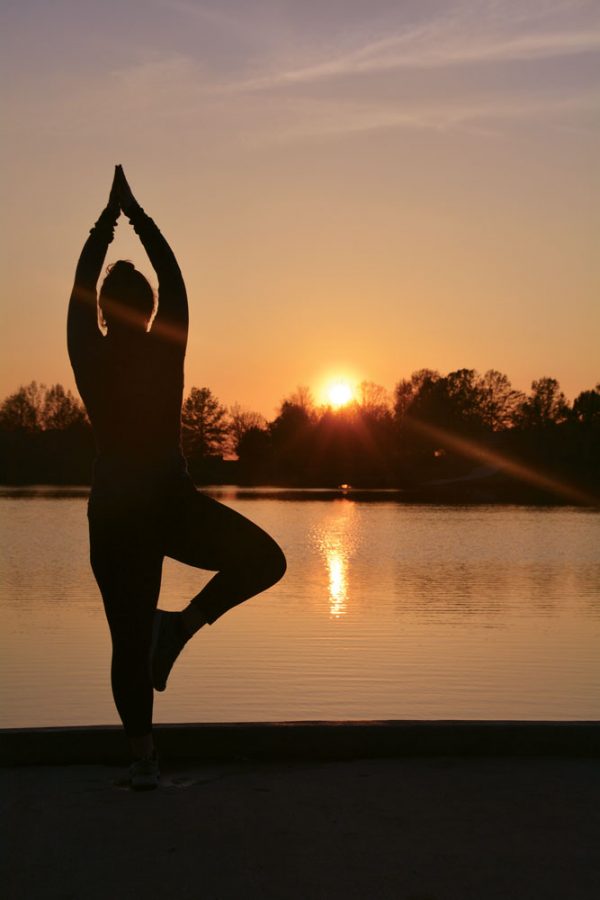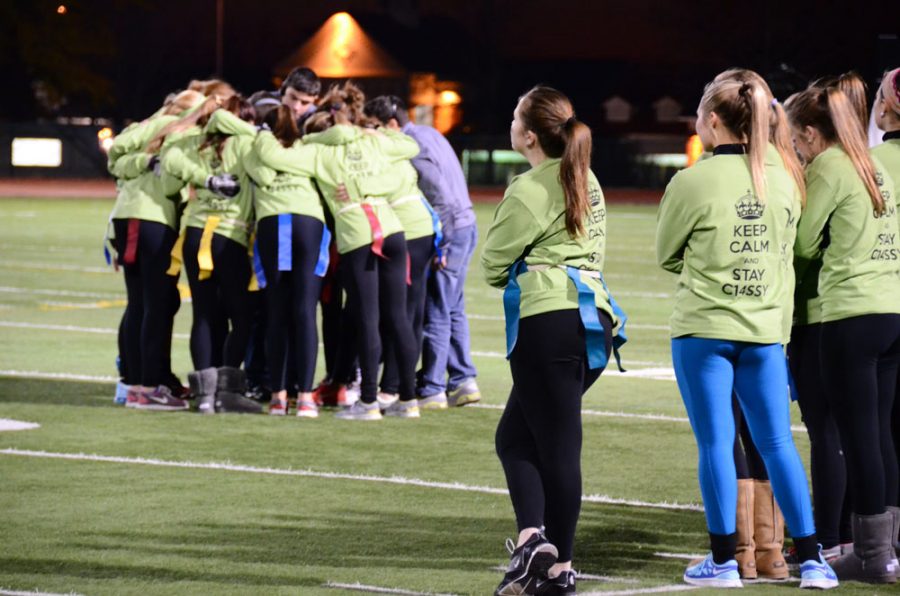It’s 9 a.m. on a Saturday. Guidance counselor Leslie Kersha walks around her yoga class, directing yogis with patience and skill refined over 16 years of instruction. She takes care to pay attention to each of her student’s form, looking over every minute detail. The class shifts into warrior two pose, breathing in slow deep breaths. Kersha quickly spots a small misalignment in one her student’s knees. She deftly calls out a cue to the class and smiles when the novice takes note and straightens her leg into a perfect 90 degree angle.
Of course, yoga doesn’t just focus on physical postures, which are called Asanas. Yoga philosophy revolves around values and guidelines for living known as the Eight Limbs of Yoga. Kersha herself specifically looks to three other limbs as approaches to live her life. Pranayama refers to proper breath technique and control, the yamas center around internal conduct such as nonviolence and truthfulness while niyamas are defined by a desire to live a wholesome and enthusiastic life. Although these values are prevalent for Kersha today, her initial exposure to yoga wasn’t quite so fundamentally spiritual.
“The first time I ever did yoga was in the mid 90s, and I bought a VHS tape of power yoga from Bryan Kest. It had three levels, which got progressively more difficult. I was young and in good shape, so I thought, ‘I’ll start off with level three.’ I did level three and didn’t do it too successfully and so I sold the VHS tapes in a garage sale,” Kersha said. “A few years later I was in Columbia. I had moved here, and I was teaching all sorts of group exercise classes at Gold’s gym. I had heard about Madonna doing yoga, and all these people doing yoga so I thought, ‘Oh, I’ll try this again.’ I rebought the set, except it was now DVD, and I started with level one and I bought a book called ‘Power Yoga’ by Beryl Bender-Birch, and I started reading that. After that I fell in love with it.”
Over the years, however, Kersha has reversed her mentality. Instead of practicing yoga solely for exercise purposes, yoga now encompasses how she lives her life.
“Initially it was about fitness and health but over the years — not that it’s not important — but I definitely see yoga as much for mental health as it’s for physical health now after I’ve been practicing for a long time. I think that’s one thing — I’m very much into yoga philosophy and psychology, of course being a counselor, psychology is very interesting to me, so my passion is the integration of yoga psychology and education and teaching people. So teaching yoga allows me to integrate all those things — health and fitness, too.”
Similarly to Kersha, junior Luke Bley was introduced to yoga through health and fitness. Bley first tried the mind-body exercise his sophomore year of high school when he heard how Alex Ofodile increased his speed and flexibility for football. Bley wasn’t too keen on the idea — his first try doing hot yoga wasn’t an optimal experience.
“I tried [hot yoga] one time my sophomore year and didn’t really prepare well for it, so it was kinda hell. I never did it again that entire year,” Bley said. “Then this offseason when I actually got into it, I got hydrated [before I went] and ate well. It was hard [and] it was really hot, but I enjoyed it.”
Bley believes the presence of an instructor during the initial stages of learning yoga was key in improving his technique, and that without a teacher the process would have been incredibly tough.
“When I first went in, I had literally no idea how to do any of the poses, and even once I thought I understood them, my technique still wasn’t very good,” Bley said. “I definitely couldn’t have done it without going to a studio with an instructor.”
Yoga instructors can help prevent injury and improve overall technique by cuing adjustments when necessary and making reminders concerning breath and concentration. Living in Columbia, where yoga is offered at more than ten locations, means easy access to the benefits that Bley experienced.
[divide color=”#”]
Benefits of yoga:
-Helps decrease chronic pain, blood pressure, excess weight and insomnia
-Increases flexibility, muscle tone, strength and circulatory health
-Promotes mental clarity, relaxation and self-awareness
-Improves athletic performance, injury recovery and vitality
source: The American Osteopathic Association
[divide color=”#”]
One of the studios, alleyCat Yoga, 17 N 4th Street, is owned and operated by Susan Mathis who wishes to bring inner peace to everyone who walks through her doors. Mathis said her personal experience with talented instructors after a long period of serious illness changed her life for the better.
“My first teacher was a CD that I practiced to in my basement before any yoga classes were regularly offered in Columbia. I found the practice challenging; after all, I didn’t have an actual teacher, but I was most drawn to the quiet space that would open up in my mind during and after practice. I searched for a way to learn more and ended up traveling to Massachusetts to the Kripalu Center for Yoga. My first real yoga class was in a very austere setting, taught by excellent teachers in the context of a full practice-lifestyle, breathing, yoga postures, focus, meditation. It was life changing,” Mathis said. “Soon after I discovered that alleyCat Yoga had opened in Columbia with Kripalu yoga teachers. I began attending regularly and became a dedicated student to yoga practice and lifestyle. The thing that most appealed to me was that I began to reconnect with my body, experience less stress, quiet my constantly chattering mind, and view others with more love and kindness.”
Kersha also contends that yoga is most definitely a lifestyle and mind-body experience that when done properly can ease mental, physical and spiritual disruption. Unfortunately, Kersha said, through social media many are led to believe that yoga is a combination of headstands, handstands and inversions. This impression of yoga is quite the opposite from the truth. To combat this, Kersha has even taken to posting “unsung yoga hero” poses with captions explaining the significance of the posture.
“When I started teaching initially in the early 2000s, Instagram didn’t exist [and] social media didn’t exist. It wasn’t like it is now. Back then people were practicing yoga to do yoga. I love social media but as [it] came about people were shooting pictures of themselves doing yoga in postures that looked more like circus acts than actual yoga poses,” Kersha said. “When you go to a yoga class you’re not going to be doing those sorts of poses. I’m kind of an old school yogi, but over the years I’ve been concerned with the fact that if you Instagram yoga, you are probably going to see a lot of arm balances, handstands, upside down inversion poses that are one small snippet of really what a yoga practice is.”
Above all Kersha makes a point to look to the future and at how finding meaning in yoga is the key to success.
“If I can do a handstand, after I leave the room my life is still my life handstand or not. If I judge my practice because I can do a handstand what happens when I’m 90 years old and can’t do a handstand? Am I going to be crushed because I can’t do a handstand anymore?,” Kersha said. “I don’t look at doing poses as a performance. I’m not doing them to show off which is why I used to never post any yoga selfies. I mean for years I would never post a yoga selfie. I made a conscious decision last year to show people that yoga is more than standing on your head, hands or inverting.”
feature photo by Tyson Jamieson
Categories:
Yoga works to connect the mind with the body
May 23, 2016
0
More to Discover



















































































